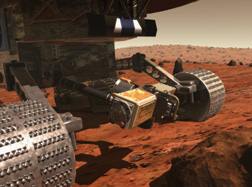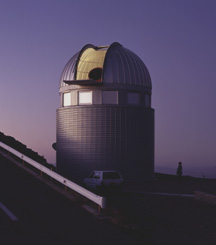
The 2003 rovers are scheduled to enter Mars'
atmosphere in January, 2004.
| Geotimes Home | Calendar | Classifieds | Subscribe | Advertise |
| Geotimes
Published by the American Geological Institute |
Newsmagazine
of the Earth Sciences
September 2000 |
Mission to
Mars: 2003
| Following the success of the 1997 Mars Pathfinder Mission, NASA announced plans in late July to construct another Mars rover that will be ready for launch in June 2003. The Mars 2003 mission will be closely related to Pathfinder — parachuting down, encased in an airbag, for a drop, bounce and roll landing — but technologically more advanced. While Pathfinder required a lander from which the Sojourner rover was deployed, the 2003 designs include the two-in-one capability of a lander and rover. The future rover will cover 100 meters per martian day (24 hours and 37 minutes) — more than Sojourner covered in its entire life traveling at a rate of 3 meters per day. Once on the surface, the rover will take a 360-degree panoramic photograph of its landing site that scientists on Earth will use to direct it toward points of interest. The mobile lander will also scratch weathered rock surfaces to reveal fresh surfaces for compositional analyses. A miniature Thermal Emission Spectrometer included in the plans will allow the robotic wanderer to view its surroundings in infrared and identify minerals formed or altered in the presence of water. | 
The 2003 rovers are scheduled to enter Mars' atmosphere in January, 2004. |
Calamitous greenhouse gas discovered
A new greenhouse gas has been discovered that might play a major role
in atmospheric warming, despite the miniscule amount present in the atmosphere.
The gas is called trifluoromethylsulphur pentafluoride (SF5CF3) and has
the highest infrared absorption known for any gas. Infrared absorption
is a measure of the amount of radiative energy that is absorbed by a molecule,
and a gas with a high infrared absorption value is a potent greenhouse
gas. Measurements of SF5CF3 from antarctic snow corings reveal that the
gas’ concentration has increased 6 percent each year from zero in 1960
to 0.12 parts per trillion in 1999. SF5CF3 is chemically related to SF6,
a manufactured gas that was targeted by the Kyoto Protocol. The collaboration
of European scientists who discovered the gas published their findings
in the July 28 issue of Science.
L.W.
| Tallying
exoplanets
In early August, three different groups of astronomers
announced the discovery of new planets orbiting other stars at the assembly
of the International Astronomical Union in Manchester, England. Reports
on the actual number of new planets discovered has varied between eight
and 10, leaving the amateur astronomer quite confused. The final count
appears to be nine. Scientists from Geneva, Switzerland, working at the
La Silla Observatory in Chile discovered six new planets, one of which
was also spotted by scientists from the University of California at Berkeley.
The Berkeley astronomers discovered two other planets in addition to the
one overlapping find. Planet-hunters at the McDonald Observatory at the
University of Texas at Austin discovered the ninth new planet, bringing
the total number of planets discovered outside our solar system to 50.
|

The Leonard Euler Telescope dome at La Silla. Courtesy of ESO Educational & Public Relations |
Plants vs. petroleum
Petroleum is a worldwide soil-contaminant problem.
Most biological methods implemented in petroleum clean up involve disturbing
the soil structure. Purdue University professors Katherine Banks and Paul
Schwab were among the first to develop alternative remediation techniques
using plants. Plants offer a cheaper, though slower, option that treats
contamination on site, leaving the soil structure intact. Plants provide
nutrients and increase the soil’s oxygen content, thus stimulating soil
microbes to break down contaminants. The plant introduced to the contamination
site must have a large root surface area and be able to survive the site’s
climate. The plant strategies already have helped to clean up contamination,
including oil and diesel spills. Multiple sites, each using a different
remediation method, are being monitored for future cost and speed comparisons.
B.M.
 |
Geotimes Home | AGI Home | Information Services | Geoscience Education | Public Policy | Programs | Publications | Careers |